当前位置:
X-MOL 学术
›
Genes Brain Behav.
›
论文详情
Our official English website, www.x-mol.net, welcomes your
feedback! (Note: you will need to create a separate account there.)
A new “sudden fright paradigm” to explore the role of (epi)genetic modulations of the DAT gene in fear‐induced avoidance behavior
Genes, Brain and Behavior ( IF 2.4 ) Pub Date : 2020-10-17 , DOI: 10.1111/gbb.12709 Silvia Zelli 1, 2 , Anna Brancato 3 , Francesca Mattioli 2 , Martina Pepe 1 , Enrico Alleva 1 , Cristiana Carbone 1 , Carla Cannizzaro 3 , Walter Adriani 1, 2
Genes, Brain and Behavior ( IF 2.4 ) Pub Date : 2020-10-17 , DOI: 10.1111/gbb.12709 Silvia Zelli 1, 2 , Anna Brancato 3 , Francesca Mattioli 2 , Martina Pepe 1 , Enrico Alleva 1 , Cristiana Carbone 1 , Carla Cannizzaro 3 , Walter Adriani 1, 2
Affiliation

|
Alterations in dopamine (DA) reuptake are involved in several psychiatric disorders whose symptoms can be investigated in knock out rats for the DA transporter (DAT‐KO). Recent studies evidenced the role of epigenetic DAT modulation in depressive‐like behavior. Accordingly, we used heterozygous (HET) rats born from both HET parents (termed MIX‐HET), compared to HET rats born from WT‐mother and KO‐father (MAT‐HET), implementing the role of maternal care on DAT modulation. We developed a “sudden fright” paradigm (based on dark‐light test) to study reaction to fearful inputs in the DAT‐KO, MAT‐HET, MIX‐HET, and WT groups. Rats could freely explore the whole 3‐chambers apparatus; then, they were gently confined in one room where they experienced the fright; finally, they could freely move again. As expected, after the fearful stimulus only MAT‐HET rats showed a different behavior consisting of avoidance towards the fear‐associated chamber, compared to WT rats. Furthermore, ex‐vivo immuno‐fluorescence reveals higher prefrontal DAT levels in MAT‐HET compared to MIX‐HET and WT rats. Immuno‐fluorescence shows also a different histone deacetylase (HDAC) enzymes concentration. Since HDAC concentration could modulate gene expression, within MAT‐HET fore brain, the enhanced expression of DAT could well impair the corticostriatal‐thalamic circuit, thus causing aberrant avoidance behavior (observed only in MAT‐HET rats). DAT expression seems to be linked to a simply different breeding condition, which points to a reduced care by HET dams for epigenetic regulation. This could imply significant prefronto‐cortical influences onto the emotional processes: hence an excessively frightful response, even to mild stressful agents, may draw developmental trajectories toward anxious and depressed‐like behavior.
中文翻译:

一种新的“突然惊吓范式”,用于探索 DAT 基因的(表观)遗传调节在恐惧诱发的回避行为中的作用
多巴胺 (DA) 再摄取的改变与几种精神疾病有关,其症状可以在敲除大鼠的 DA 转运蛋白 (DAT-KO) 中进行研究。最近的研究证明了表观遗传 DAT 调节在抑郁样行为中的作用。因此,我们使用了从 HET 父母(称为 MIX-HET)出生的杂合子 (HET) 大鼠,与从 WT 母亲和 KO 父亲 (MAT-HET) 出生的 HET 大鼠相比,实施母体护理对 DAT 调节的作用。我们开发了一种“突然惊吓”范式(基于暗光测试)来研究 DAT-KO、MAT-HET、MIX-HET 和 WT 组对恐惧输入的反应。大鼠可以自由探索整个 3 腔装置;然后,他们被轻轻地关在一个房间里,在那里他们经历了恐惧;终于,他们又可以自由活动了。正如预期的那样,与 WT 大鼠相比,在恐惧刺激后,只有 MAT-HET 大鼠表现出不同的行为,包括回避与恐惧相关的腔室。此外,与 MIX-HET 和 WT 大鼠相比,离体免疫荧光显示 MAT-HET 的前额叶 DAT 水平更高。免疫荧光也显示出不同的组蛋白去乙酰化酶 (HDAC) 酶浓度。由于 HDAC 浓度可以调节基因表达,在 MAT-HET 前脑内,DAT 的增强表达可能会损害皮质纹状体-丘脑回路,从而导致异常回避行为(仅在 MAT-HET 大鼠中观察到)。DAT 表达似乎与一种完全不同的繁殖条件有关,这表明 HET 水坝对表观遗传调控的关注减少。这可能意味着对情绪过程的前额皮质有显着影响:
更新日期:2020-10-17
中文翻译:

一种新的“突然惊吓范式”,用于探索 DAT 基因的(表观)遗传调节在恐惧诱发的回避行为中的作用
多巴胺 (DA) 再摄取的改变与几种精神疾病有关,其症状可以在敲除大鼠的 DA 转运蛋白 (DAT-KO) 中进行研究。最近的研究证明了表观遗传 DAT 调节在抑郁样行为中的作用。因此,我们使用了从 HET 父母(称为 MIX-HET)出生的杂合子 (HET) 大鼠,与从 WT 母亲和 KO 父亲 (MAT-HET) 出生的 HET 大鼠相比,实施母体护理对 DAT 调节的作用。我们开发了一种“突然惊吓”范式(基于暗光测试)来研究 DAT-KO、MAT-HET、MIX-HET 和 WT 组对恐惧输入的反应。大鼠可以自由探索整个 3 腔装置;然后,他们被轻轻地关在一个房间里,在那里他们经历了恐惧;终于,他们又可以自由活动了。正如预期的那样,与 WT 大鼠相比,在恐惧刺激后,只有 MAT-HET 大鼠表现出不同的行为,包括回避与恐惧相关的腔室。此外,与 MIX-HET 和 WT 大鼠相比,离体免疫荧光显示 MAT-HET 的前额叶 DAT 水平更高。免疫荧光也显示出不同的组蛋白去乙酰化酶 (HDAC) 酶浓度。由于 HDAC 浓度可以调节基因表达,在 MAT-HET 前脑内,DAT 的增强表达可能会损害皮质纹状体-丘脑回路,从而导致异常回避行为(仅在 MAT-HET 大鼠中观察到)。DAT 表达似乎与一种完全不同的繁殖条件有关,这表明 HET 水坝对表观遗传调控的关注减少。这可能意味着对情绪过程的前额皮质有显着影响:











































 京公网安备 11010802027423号
京公网安备 11010802027423号